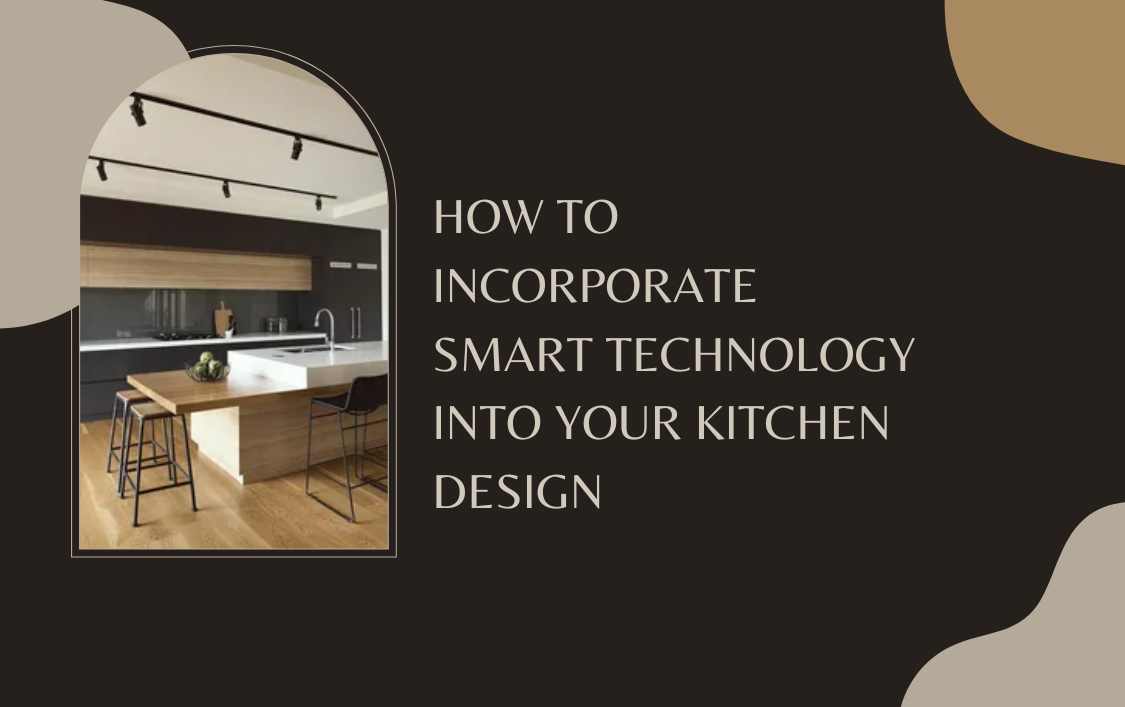The kitchen is often considered the heart of the home, a place where meals are prepared, and families gather. In recent years, the integration of smart technology has revolutionized kitchen design, making it more efficient, convenient, and enjoyable. This comprehensive guide will help you understand how to incorporate smart technology into your kitchen design, ensuring that you create a modern, functional, and stylish space.
Understanding Smart Kitchen Technology
What is Smart Kitchen Technology?
Smart kitchen technology refers to the use of internet-connected devices and appliances that can be controlled remotely via a smartphone, tablet, or voice assistant. These devices offer advanced features that enhance convenience, efficiency, and safety in the kitchen. Examples include smart refrigerators, ovens, dishwashers, and lighting systems.
Benefits of a Smart Kitchen
Incorporating smart technology into your kitchen offers numerous benefits, including:
- Increased Convenience: Control your appliances and devices remotely, making daily tasks easier.
- Enhanced Efficiency: Automate routine tasks and streamline your cooking process.
- Energy Savings: Smart appliances often use energy more efficiently, reducing your utility bills.
- Improved Safety: Monitor and control kitchen activities from anywhere, enhancing safety.
- Modern Aesthetic: Smart technology can add a sleek, modern look to your kitchen design.
Note :- Ready to transform your cooking space with the latest smart technology? Contact our expert team for a consultation and discover how we can enhance your Kitchen Design in Dubai. Click here to get started and bring innovation and style into your home!
Planning Your Smart Kitchen
Assess Your Needs and Goals
Before you start incorporating smart technology into your kitchen, assess your needs and goals. Consider the following questions:
- What are the main tasks and activities in your kitchen?
- Which smart devices or appliances will enhance your kitchen experience?
- What is your budget for upgrading to smart technology?
- How tech-savvy are you and your family members?
Research Smart Kitchen Devices
Conduct thorough research on available smart kitchen devices and appliances. Read reviews, compare features, and consider compatibility with your existing devices. Some popular smart kitchen devices include:
- Smart Refrigerators: These offer features like touchscreen interfaces, interior cameras, and inventory tracking.
- Smart Ovens and Ranges: Control cooking settings remotely, receive alerts, and access recipes.
- Smart Dishwashers: Schedule wash cycles, monitor detergent levels, and receive maintenance alerts.
- Smart Lighting: Adjust lighting settings remotely or use voice commands.
- Smart Speakers and Displays: Use voice assistants to control devices, access recipes, and set timers.
Create a Smart Kitchen Layout
Designing a functional and efficient kitchen layout is crucial for maximizing the benefits of smart technology. Consider the following tips:
- Work Triangle: Ensure the key areas (sink, stove, and refrigerator) form a triangle to optimize workflow.
- Accessible Controls: Position smart device controls within easy reach for convenience.
- Integrated Storage: Plan for adequate storage for smart devices and related accessories.
Selecting Smart Kitchen Appliances
Smart Refrigerators
Features to Look For
When choosing a smart refrigerator, consider features such as:
- Touchscreen Interface: Provides easy access to controls, calendars, and entertainment.
- Interior Cameras: Allow you to check the contents of your fridge remotely.
- Inventory Tracking: Keeps track of expiration dates and suggests recipes based on available ingredients.
- Energy Efficiency: Reduces energy consumption and utility costs.
Popular Models
Some popular smart refrigerator models include:
- Samsung Family Hub: Known for its large touchscreen and comprehensive smart features.
- LG InstaView ThinQ: Features a sleek design and advanced smart capabilities.
- Whirlpool Smart Refrigerator: Offers compatibility with multiple smart home systems.
Smart Ovens and Ranges
Features to Look For
Smart ovens and ranges can significantly enhance your cooking experience. Key features to consider include:
- Remote Control: Adjust temperature and cooking settings from your smartphone.
- Voice Control: Use voice commands to control the oven through a smart assistant.
- Recipe Integration: Access recipes and automatic cooking programs.
- Self-Cleaning: Schedule and control the self-cleaning function remotely.
Popular Models
Some popular smart oven and range models include:
- GE Profile Smart Oven: Offers remote control, voice commands, and a built-in camera.
- Bosch HBL8753UC: Features Home Connect for remote control and recipe integration.
- Samsung Flex Duo: Provides flexibility with dual oven capabilities and smart controls.
Smart Dishwashers
Features to Look For
Smart dishwashers can make cleaning up after meals more efficient. Key features to consider include:
- Remote Monitoring: Check the status of your dishwasher and receive alerts.
- Scheduled Wash Cycles: Set wash cycles to run at convenient times.
- Water Usage Tracking: Monitor and optimize water usage.
- Maintenance Alerts: Receive notifications for maintenance and repairs.
Popular Models
Some popular smart dishwasher models include:
- Bosch 800 Series: Known for its quiet operation and Home Connect features.
- LG Smart Dishwasher: Offers QuadWash technology and remote control via the ThinQ app.
- Samsung Linear Wash: Features a linear wash system and smart connectivity.
Smart Lighting
Features to Look For
Smart lighting can enhance both the functionality and ambiance of your kitchen. Key features to consider include:
- Adjustable Brightness: Control the brightness of your lights remotely.
- Color Temperature Control: Adjust the color temperature to suit different tasks and moods.
- Voice Control: Use voice commands to control your lighting.
- Scheduling: Set schedules for your lights to turn on and off automatically.
Popular Models
Some popular smart lighting options include:
- Philips Hue: Known for its wide range of smart bulbs and advanced features.
- LIFX Smart Bulbs: Offer vibrant colors and easy integration with smart home systems.
- Nanoleaf Light Panels: Provide customizable lighting designs and smart controls.
Integrating Smart Technology
Smart Home Hubs and Assistants
Choosing a Smart Home Hub
A smart home hub can help you control all your smart kitchen devices from a single interface. Consider the following options:
- Amazon Echo: Integrates with Alexa for voice control and compatibility with numerous smart devices.
- Google Nest Hub: Uses Google Assistant to control devices, display recipes, and provide hands-free help.
- Apple HomePod: Works with Siri and the HomeKit ecosystem for seamless integration.
Setting Up and Syncing Devices
Initial Setup
Follow these steps to set up your smart kitchen devices:
- Install the Device: Follow the manufacturer’s instructions for physical installation.
- Connect to Wi-Fi: Ensure your device is connected to your home Wi-Fi network.
- Download the App: Download the corresponding app for your device on your smartphone or tablet.
- Create an Account: Set up an account if required by the app.
- Pair the Device: Follow the app’s instructions to pair the device with your account.
Syncing with Other Devices
To sync your smart kitchen devices with other smart home devices:
- Open the Smart Home App: Use the app for your smart home hub (e.g., Alexa, Google Home, Apple Home).
- Add a New Device: Follow the instructions to add a new device.
- Select the Device Type: Choose the type of device you are adding (e.g., smart oven, smart light).
- Complete Pairing: Follow the prompts to complete the pairing process.
Using Voice Commands
Setting Up Voice Assistants
To use voice commands with your smart kitchen devices:
- Enable Voice Assistant: Ensure your smart home hub’s voice assistant (e.g., Alexa, Google Assistant, Siri) is enabled.
- Link Devices: Link your smart kitchen devices to the voice assistant through the app.
- Create Voice Commands: Set up custom voice commands for your devices (e.g., “Alexa, preheat the oven to 350 degrees”).
Common Voice Commands
Here are some common voice commands you can use in your smart kitchen:
- Oven: “Hey Google, set the oven to 400 degrees.”
- Refrigerator: “Alexa, add milk to my shopping list.”
- Lighting: “Siri, turn on the kitchen lights.”
- Timer: “Hey Google, set a timer for 10 minutes.”
Enhancing Kitchen Safety with Smart Technology
Smart Smoke and Carbon Monoxide Detectors
Smart smoke and carbon monoxide detectors enhance kitchen safety by providing real-time alerts and monitoring. Features to look for include:
- Remote Alerts: Receive notifications on your smartphone if smoke or carbon monoxide is detected.
- Integration with Other Devices: Sync with other smart devices to take actions like turning off the oven.
- Self-Testing: Automatic self-testing to ensure the detector is functioning correctly.
Smart Security Cameras
Installing smart security cameras in your kitchen can provide an additional layer of safety. Key features to consider include:
- Live Streaming: View real-time footage from your smartphone.
- Motion Detection: Receive alerts when motion is detected in your kitchen.
- Two-Way Audio: Communicate through the camera’s built-in microphone and speaker.
Maintaining Your Smart Kitchen
Regular Maintenance
Keep your smart kitchen devices running smoothly with regular maintenance:
- Update Software: Ensure that your devices and apps are updated with the latest software.
- Clean Appliances: Follow the manufacturer’s instructions for cleaning and maintaining your smart appliances.
- Check Connections: Periodically check that all devices are properly connected to your Wi-Fi network.
Discription
Incorporating smart technology into your kitchen design can transform it into a modern, efficient, and stylish space. This guide covers everything from understanding the benefits of smart kitchen technology to selecting the right appliances and integrating them seamlessly into your kitchen.
You’ll learn how to plan your smart kitchen by assessing your needs, researching the latest smart devices, and creating an efficient layout. Discover key features to look for in smart refrigerators, ovens, dishwashers, and lighting to enhance your kitchen’s functionality and aesthetics.
The guide also provides tips on setting up and syncing your smart devices, using voice commands for convenience, and enhancing kitchen safety with smart smoke detectors and security cameras. Regular maintenance and troubleshooting advice ensure your smart kitchen remains in top condition.
By following these steps, you can enjoy the convenience, efficiency, and modern appeal of a smart kitchen tailored to your lifestyle.
Note :- Read more related blogs at www.whoisblogworld.com





